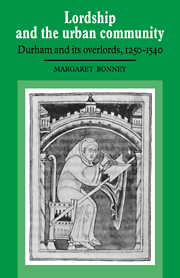Book contents
- Frontmatter
- Contents
- Acknowledgements
- List of abbreviations
- INTRODUCTION
- 1 URBAN ORIGINS: THE GROWTH AND DEVELOPMENT OF DURHAM TO 1250
- 2 THE URBAN LANDSCAPE OF DURHAM 1250–1540
- 3 DURHAM'S MEDIEVAL BUILDINGS
- 4 LANDLORD AND TENANTS: THE ECONOMIC RELATIONSHIP BETWEEN DURHAM PRIORY AND ITS URBAN TENANTS IN THE LATER MIDDLE AGES
- 5 TRADES AND OCCUPATIONS
- 6 LORDSHIP IN ACTION: THE MAINTENANCE OF LAW AND ORDER IN LATE-MEDIEVAL DURHAM
- CONCLUSION: LORDSHIP AND COMMUNITY: THE RELATIONS BETWEEN DURHAM AND ITS ECCLESIASTICAL OVERLORDS IN THE LATER MIDDLE AGES
- Appendix 1 Maps and plans of Durham
- Appendix 2 Tables
- Appendix 3 The dates of the bishops of Durham from 995 to the Dissolution
- Appendix 4 The obedientiaries of Durham Priory
- Appendix 5 The Durham courts
- Bibliography
- Index
CONCLUSION: LORDSHIP AND COMMUNITY: THE RELATIONS BETWEEN DURHAM AND ITS ECCLESIASTICAL OVERLORDS IN THE LATER MIDDLE AGES
Published online by Cambridge University Press: 06 January 2010
- Frontmatter
- Contents
- Acknowledgements
- List of abbreviations
- INTRODUCTION
- 1 URBAN ORIGINS: THE GROWTH AND DEVELOPMENT OF DURHAM TO 1250
- 2 THE URBAN LANDSCAPE OF DURHAM 1250–1540
- 3 DURHAM'S MEDIEVAL BUILDINGS
- 4 LANDLORD AND TENANTS: THE ECONOMIC RELATIONSHIP BETWEEN DURHAM PRIORY AND ITS URBAN TENANTS IN THE LATER MIDDLE AGES
- 5 TRADES AND OCCUPATIONS
- 6 LORDSHIP IN ACTION: THE MAINTENANCE OF LAW AND ORDER IN LATE-MEDIEVAL DURHAM
- CONCLUSION: LORDSHIP AND COMMUNITY: THE RELATIONS BETWEEN DURHAM AND ITS ECCLESIASTICAL OVERLORDS IN THE LATER MIDDLE AGES
- Appendix 1 Maps and plans of Durham
- Appendix 2 Tables
- Appendix 3 The dates of the bishops of Durham from 995 to the Dissolution
- Appendix 4 The obedientiaries of Durham Priory
- Appendix 5 The Durham courts
- Bibliography
- Index
Summary
This survey of the urban community at Durham between c. 1250 and 1540 was motivated by a wish to redress the balance of previous work, most notably to draw some attention away from its ecclesiastical rulers towards the town that lay at the heart of their temporal power. Furthermore, an attempt has been made to set Durham in the context of medieval urban history, to assess its economic and social status in relation to other English towns in the same period. Some broad general conclusions can be drawn from this study as a whole which, it is hoped, will be of significance to those working on, or interested in, the history of medieval towns. Clearly, Durham was a town whose period of physical growth had largely come to an end by the middle of the thirteenth century. The boundaries of the urban area were, more or less, established before 1250 and the borough divisions were already entrenched, and this urban landscape saw no dramatic changes in the later medieval period. Durham was a small market town with a restricted hinterland; it lacked good communications by land or water which benefited her neighbours, in particular Newcastle-upon-Tyne. Her trades and industries were small scale and produced goods primarily for a loćal market; consequently, the town probably did not exercise a powerful magnetic attraction towards the labouring poor from the surrounding region. Yet the very diversity of her trades and the lack of any one predominant manufacturing industry does mean, however, that Durham seems to have escaped the worst consequences of economic decline in the fifteenth and early sixteenth centuries.
- Type
- Chapter
- Information
- Lordship and the Urban CommunityDurham and its Overlords, 1250–1540, pp. 229 - 236Publisher: Cambridge University PressPrint publication year: 1990



